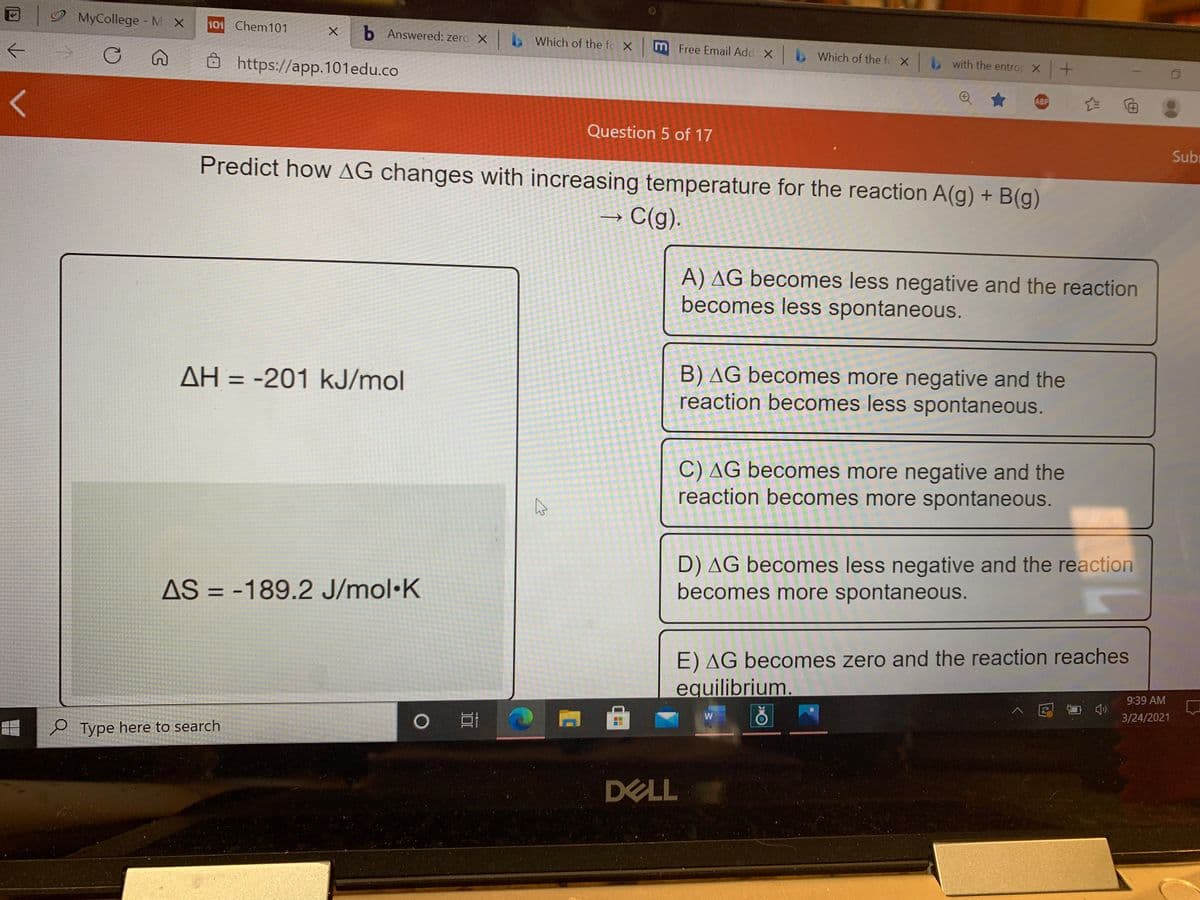Sub Predict how AG changes with increasing temperature for the reaction A(g) + B(g) → C(g). A) AG becomes less negative and the reaction becomes less spontaneous. B) AG becomes more negative and the reaction becomes less spontaneous. AH = -201 kJ/mol C) AG becomes more negative and the reaction becomes more spontaneous. AS = -189.2 J/mol·K D) AG becomes less negative and the reaction becomes more spontaneous. E) AG becomes zero and the reaction reaches equilibrium. 9:39 AM
Sub Predict how AG changes with increasing temperature for the reaction A(g) + B(g) → C(g). A) AG becomes less negative and the reaction becomes less spontaneous. B) AG becomes more negative and the reaction becomes less spontaneous. AH = -201 kJ/mol C) AG becomes more negative and the reaction becomes more spontaneous. AS = -189.2 J/mol·K D) AG becomes less negative and the reaction becomes more spontaneous. E) AG becomes zero and the reaction reaches equilibrium. 9:39 AM
Chemistry: Principles and Reactions
8th Edition
ISBN:9781305079373
Author:William L. Masterton, Cecile N. Hurley
Publisher:William L. Masterton, Cecile N. Hurley
Chapter8: Thermochemistry
Section: Chapter Questions
Problem 90QAP: Consider a metal ion A2+ and its nitrate salt, In an experiment, 35.00 mL of a 0.217 M solution of...
Related questions
Question

Transcribed Image Text:|2 MyCollege - M X
101 Chem101
b Answered: zero X b Which of the fc Xm Free Email Add X b Which of the fo X with the entro X
8 https://app.101edu.co
ABP
Question 5 of 17
Sub
Predict how AG changes with increasing temperature for the reaction A(g) + B(g)
→ C(g).
->
A) AG becomes less negative and the reaction
becomes less spontaneous.
B) AG becomes more negative and the
reaction becomes less spontaneous.
AH = -201 kJ/mol
%3D
C) AG becomes more negative and the
reaction becomes more spontaneous.
AS = -189.2 J/mol•K
D) AG becomes less negative and the reaction
becomes more spontaneous.
%3D
E) AG becomes zero and the reaction reaches
equilibrium.
9:39 AM
ヘ园 台
3/24/2021
e Type here to search
DELL
Expert Solution
This question has been solved!
Explore an expertly crafted, step-by-step solution for a thorough understanding of key concepts.
Step by step
Solved in 2 steps with 1 images

Knowledge Booster
Learn more about
Need a deep-dive on the concept behind this application? Look no further. Learn more about this topic, chemistry and related others by exploring similar questions and additional content below.Recommended textbooks for you

Chemistry: Principles and Reactions
Chemistry
ISBN:
9781305079373
Author:
William L. Masterton, Cecile N. Hurley
Publisher:
Cengage Learning

Chemistry: Principles and Reactions
Chemistry
ISBN:
9781305079373
Author:
William L. Masterton, Cecile N. Hurley
Publisher:
Cengage Learning